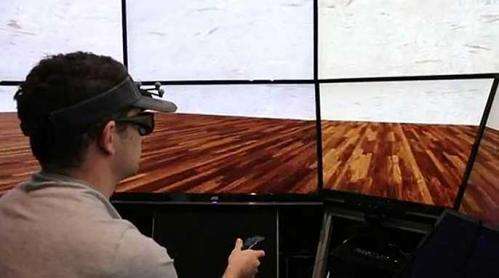Virtual reality guides those whose memory is failing

Experts agree that the ability to navigate a neighborhood or built space is one of the first faculties to suffer at the onset of cognitive decline. They also agree that early intervention is crucial for stemming the further ravages of dementia.
But catching adults "in the act" of unsuccessfully navigating space is a challenging and expensive research problem—one that a new low-cost, virtual-reality based tool being developed at the University of California, San Diego's Qualcomm Institute hopes to address.
The VE-HuNT System (Virtual Environment Human Navigation Task), a research endeavor of UC San Diego neuroscience professor Eduardo Macagno, is a combination of hardware and software that will immerse test subjects in a human-scale, interactive, virtual-reality-based 'room.' Users use a device akin to a steering wheel and gas pedal to navigate the room, which is created in 3-D in a portable, office-sized version the Qualcomm Institute's NexCAVE or StarCAVE environments. The subjects are asked to perform a series of increasingly difficult navigational tasks, such as finding a colored tile on the floor with and without navigational cues.
"The idea is to give an older person a series of tests and see where they fail," says Macagno. "We record how long it takes them, which paths they take." Macagno says a steering wheel was selected over a remote control for the task because aging users are more likely to have familiarity with the former over the latter.
Macagno has spent several years working with Qualcomm Institute assistant research scientist Jurgen Schulze with funding from San Diego-based HMC Architects to design virtual built environments for various research endeavors at the intersection of architecture, neuroscience and cognitive science. QI Director of Visualization Thomas DeFanti and professor of psychiatry Dilip Jeste of the UC San Diego Center for Research and Aging also are collaborators on the clinical expansion of that research.
"Especially in health care," notes Macagno, "there are many applications of virtual-reality technology which have not yet been implemented in medical professionals' workflows." He adds that current diagnostic tools, such as volumetric MRI or PET scans are very expensive and would not be feasible for assessing all patients in their 50s (or younger) when a diagnosis of risk would be most useful.
"The use of VR head-mounted displays such as Oculus Rift has also been proposed," he adds, "but HMDs have the negative property that the user feels disembodied and cannot see herself, which often leads to vertigo or other vestibular problems. Perhaps more importantly, head-mounted displays are characterized by a significant loss of peripheral vision, which is known to be very important in human navigation."
The first trial of the VE-HuNT System will take place at the UC San Diego Center for Neurodegenerative Diseases and involve 20 adults in varying stages of cognitive decline as well as 20 control subjects. Several software packages built from QI's custom CAVE-CAD software will be developed for the trials, as will an algorithm derived from electro-oculography (EOG) data recorded synchronously in the StarCAVE. The algorithm is designed to track a user's visual attention of moving objects and can provide quantitative and reproducible measures of visuospatial abilities. Subjects undergoing specific treatments for cognitive impairment can be compared to controls to determine the most effective interventions.
"Dementia is truly the epidemic of our times," Macagno remarks. "There are more than 5 million people in the U.S. who have been diagnosed with dementia. We expect that this tool could be widely employed by biomedical and clinical researchers, health care providers, designers and, potentially, health-care architects."
Provided by University of California - San Diego



















